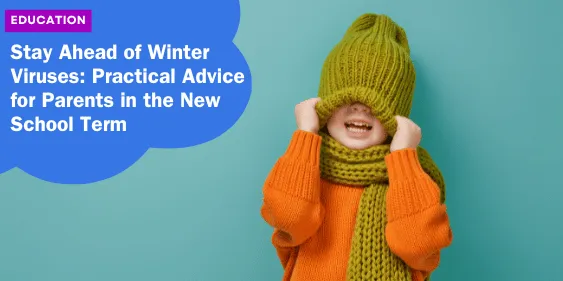Stay Ahead of Winter Viruses: Practical Advice for Parents in the New School Term

The protection of children’s health can often begin with the fundamental practice of hand-washing.
Health professionals consistently emphasize the effectiveness of this simple act in preventing the spread of harmful viruses.
But why is consistent hand-washing so essential, especially within the bustling environment of schools?
Regular Hand-Washing: A Virus’s Nemesis
Hand-washing extends beyond a mere routine; it is a critical component of virus prevention. When hands are washed with soap and water, the process efficiently breaks down the grease and dirt that harbor most germs, effectively neutralizing viruses.
Research indicates that regular hand-washing can lower the risk of respiratory infections by 16-21%.
This represents a significant defense against common winter viruses, which tend to proliferate as children return to school.
Unseen but Not Unfelt: Viruses on Hands
Daily interactions with various surfaces—such as doorknobs, tablets, and toys—expose hands to unseen viruses like the common cold, flu, and gastrointestinal bugs.
These pathogens can persist on hands for extended periods, making it easy for them to be transferred to the mouth, nose, or eyes.
Implementing robust hygiene practices, such as washing hands before meals, after using the restroom, and following sneezing or coughing, significantly curtails the risk of infection.
A Lesson in Hygiene: Protecting Everyone
Teaching children proper hygiene goes beyond individual health; it contributes to community well-being.
When children learn to practice good hygiene, they are not only protecting themselves but also their classmates, teachers, and family members. Educating children about the importance of hygiene fosters a sense of responsibility and communal health.
Indeed, a healthy community begins with healthy individuals, and healthy habits stem from effective education.
Strategies to Stop the Spread of Stomach Bugs
As winter arrives, so does the increase in stomach bugs such as norovirus and E. coli. T
hese pathogens are notorious for causing gastrointestinal issues like diarrhea and vomiting, particularly among younger children.
The impact extends beyond physical discomfort, leading to high rates of absenteeism and significant disruption in educational settings.
Rise in Sickness Bugs
The winter months see a rise in these sickness bugs, primarily because norovirus, also known as the winter vomiting bug, thrives in cooler conditions and enclosed spaces, making schools ideal environments for its spread.
E. coli, a bacteria that can be transmitted through contaminated food or water and person-to-person contact, also becomes more prevalent.
These germs can persist on surfaces or hands and are easily transmitted among children.
Therefore, when one child becomes ill, the potential for a widespread outbreak increases rapidly.
Importance of Disinfection
Effective disinfection plays a crucial role in combating these pathogens.
Bleach-based cleaning products are particularly efficient at disinfecting surfaces and eliminating the germs responsible for stomach bugs.
Regularly cleaning high-touch areas such as doorknobs, bathroom fixtures, and toys is especially important in communal spaces like schools.
This practice significantly reduces the likelihood of outbreaks.
Hand-Washing with Soap
In addition to cleaning practices, hand-washing with soap is an essential tool in preventing the spread of illness.
Regular and thorough hand hygiene breaks the cycle of infection, preventing viruses and bacteria from being transferred from hands to the mouth.
Encouraging children to wash their hands after using the restroom, before eating, and following sneezing or coughing is a straightforward yet impactful measure.
This practice effectively helps to halt the transmission of viruses.
Impact on School Environment
Implementing these hygiene strategies not only protects individual students but also strengthens the overall health of the school environment.
Schools that enforce rigorous cleaning protocols and promote regular hand-washing typically experience fewer cases of stomach bugs.
This leads to more consistent classroom attendance, uninterrupted learning, and a healthier school community.
When children internalize the importance of these practices, they extend these habits beyond school, benefiting their families and the broader community.
Knowing When to Keep Your Child at Home
With the onset of winter viruses, parents must know when to keep their child home from school.
Properly understanding the criteria for staying home is essential for both the child’s health and the well-being of their peers.
Recognizing Symptoms That Mean Stay Home
A high temperature is often the first sign that a child may need to stay home.
Fever typically indicates that the body is fighting an infection, which may necessitate a period of rest.
Accompanying symptoms such as fatigue, persistent coughing, or general discomfort also suggest that the child might be unwell.
It is wise to keep the child at home in such cases to facilitate recovery and prevent the spread of illness to others.
The 48-Hour Rule for Gastrointestinal Issues
For stomach bugs, following the 48-hour rule is critical.
If a child has experienced diarrhea or vomiting, they should remain at home for at least 48 hours after the last episode.
This period ensures that the child is no longer contagious and minimizes the risk of further spread among classmates.
Adhering to this guideline not only aids in the child’s recovery but also helps contain potential outbreaks.
Post-Antibiotics: The 24-Hour Guide
When antibiotics have been prescribed, keeping the child home for at least 24 hours after the initial dose is recommended.
This allows the medication to take effect and reduces the likelihood of spreading bacterial infections.
Prompt medical consultation and adherence to treatment guidelines are crucial for effective management of infections.
Encouraging Vaccination for Flu Prevention
Vaccination remains one of the most effective methods for preventing the flu.
UK health authorities advocate for the nasal spray flu vaccine as the optimal defense for children against influenza.
This simple and painless option is specifically designed for younger children, making the vaccination process less intimidating.
A Nasal Spray That Makes a Difference
The nasal spray vaccine offers a quick and needle-free alternative, making it a more child-friendly option.
This method not only simplifies the vaccination experience but also proves highly effective in preventing flu.
Research supports the vaccine’s efficacy in avoiding severe complications that can arise from influenza, particularly in young children.
Tackling Low Vaccine Uptake Among Pre-Schoolers
Despite the benefits, flu vaccine uptake among pre-schoolers remains below desired levels.
This age group is especially vulnerable to the flu, which can lead to severe illness or hospitalization.
Raising awareness about the vaccine’s importance is crucial, ensuring that parents understand its significance for their child’s health and the broader community.
Who Can Get the Vaccine?
In the UK, the flu vaccine is available for free to children within specific age ranges.
While eligibility criteria may vary slightly across Wales, England, Scotland, and Northern Ireland, generally, children aged 2 to 11 are offered the vaccine.
Parents should verify details with their local health services to ensure their child benefits from this protective measure.
Promoting awareness of eligibility encourages parents to take advantage of the vaccine, thus bolstering community health.
Conclusion and Call-to-Action
To conclude, implementing effective strategies can help keep children safe from winter viruses.
A coordinated approach involving parents, schools, and communities can substantially reduce the spread of illnesses.
Emphasizing good hygiene practices, especially regular hand-washing, serves as a powerful tool in virus prevention.
Understanding that germs can linger on hands underscores the importance of thorough hand hygiene.
Maintaining cleanliness at home and in educational settings is equally vital.
The rise of stomach bugs like norovirus and E.
coli highlights the need for regular disinfection using bleach-based products.
Combined with diligent hand-washing, these practices offer robust protection against infectious agents in schools.
Moreover, knowing when to keep a child home is essential for controlling illness spread.
Recognizing symptoms and adhering to guidelines, such as the 48-hour rule for gastrointestinal issues and the 24-hour rule for post-antibiotic use, helps manage health effectively.
Vaccination remains a critical preventive measure against the flu, with the nasal spray vaccine offering an accessible option for children.
It is imperative for parents to take proactive steps to safeguard their children’s health.
By reinforcing proper hygiene, advocating for cleanliness, adhering to health guidelines, and ensuring vaccination, we contribute to a healthier and more resilient community.
Let’s work together to ensure a safe and uninterrupted school term, demonstrating our commitment to the well-being of our children and the broader community. Your actions today will have a lasting impact on their health and educational success.






